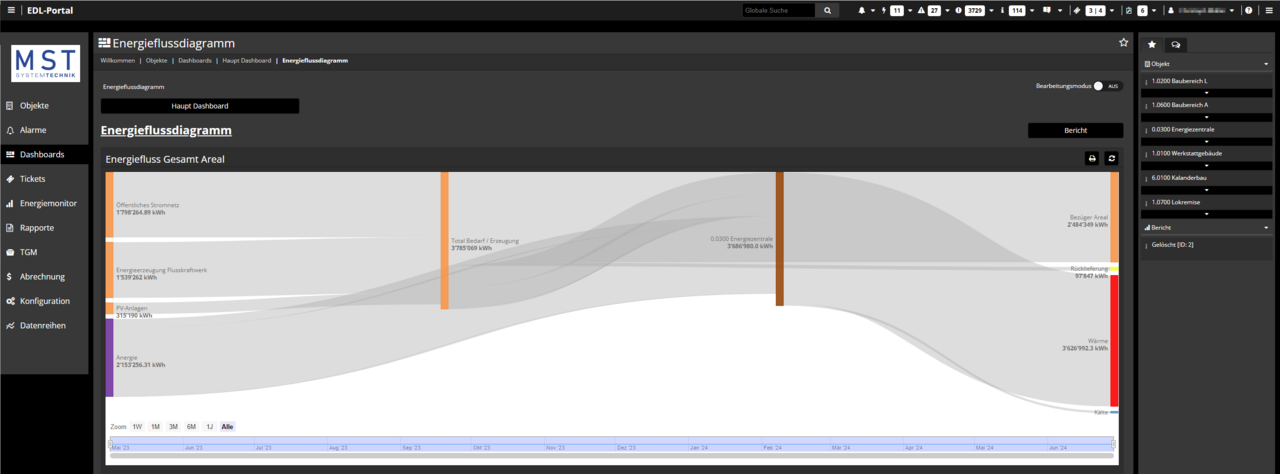
Integration of measurement and sensor technology
The integration of measurement and sensor technology into the EDL portal plays a central role in the effective monitoring and control of energy consumption. Through precise and continuous data collection, operators can optimize the operation of their systems, reduce costs and achieve sustainability goals.
1. Importance of measurement and sensor technology
Measurement and sensor technology is crucial for the accurate recording of energy consumption data and environmental parameters. These technologies provide the necessary data, which is analysed and visualized in the EDL portal in order to make informed decisions on energy optimization.
2. Main components of measurement and sensor technology
2.1. Sensors
- Temperature sensors: Measure the ambient temperature and the temperature of heating and cooling systems.
- Humidity sensors: Detect the humidity in various areas of the building.
- Air quality sensors: Detect CO₂, VOC, particulate matter, etc. in the air.
- Motion sensors: Detect the presence of people to control lighting and HVAC systems.
- Light sensors: Measure light intensity and support the adjustment of lighting.
2.2. Measuring devices
- Energy meters: Measure the electricity, gas and water consumption of individual installations and systems.
- Power meters: Monitor electrical power and energy quality.
- Flow meters: Record the flow of water, oil and gas in pipes.
2.3. Communication modules
- EDL boxes: Store and transmit recorded data to the EDL portal.
- Gateways: Connect various sensors and measuring devices to the EDL portal network.
3. Functions of the measurement and sensor technology in the EDL portal
3.1. Real-time monitoring
- Data acquisition: Sensors and measuring devices continuously record data on energy consumption and ambient conditions.
- Data transmission: The recorded data is transmitted in real time to the EDL portal, where it can be visualized and analysed.
3.2. Analysis and reporting
- Data analysis: The EDL portal analyzes the recorded data, identifies trends and anomalies and provides valuable insights into energy efficiency.
- Reports: Automated reports document energy consumption, operational efficiency and potential savings.
3.3. Automation and control
- Rule-based control: HVAC, lighting and other technical building systems can be controlled automatically based on the data collected.
- Optimization: Through continuous monitoring and analysis, operating strategies are optimized to minimize energy consumption.
3.4. Alarm and fault management
- Real-time alarms: In the event of deviations from defined target values or faults, alarms are triggered and sent to the responsible persons.
- Fault logs: All alarms and faults are logged in detail so that root cause analyses and troubleshooting measures can be carried out.
4. Advantages of integrating measurement and sensor technology
4.1. Precise data acquisition
- By using modern sensors and measuring devices, accurate and reliable data is collected, which forms the basis for effective energy optimization strategies.
4.2. Cost savings
- Precise monitoring of energy consumption enables potential savings to be identified and efficient operating strategies to be implemented, resulting in considerable cost savings.
4.3. Increasing energy efficiency
- Continuous data collection and analysis help to identify and eliminate inefficient operating practices, significantly increasing energy efficiency.
4.4. Improving operational management
- Precise control and monitoring of the building's technical systems leads to improved operating efficiency and increases comfort for building users.
4.5. Support for sustainability goals
- The integration of measurement and sensor technology supports the implementation and monitoring of sustainability strategies and the achievement of environmental and energy certifications.
Conclusion
The integration of measurement and sensor technology in conjunction with the EDL portal offers comprehensive opportunities to optimize energy consumption, improve operational efficiency and support sustainability goals. Through accurate and continuous data collection, operators can make informed decisions, realize cost savings and achieve long-term sustainable success. Careful implementation and continuous use of these technologies ensure that the benefits are fully realized and that the systems are operated optimally.

